In this pork pot roast recipe, a boneless pork shoulder is cooked low and slow on the stovetop with simple herbs, spices, and vegetables until it's fall-apart tender. This easy, flavorful dish is perfect for a hearty family dinner.
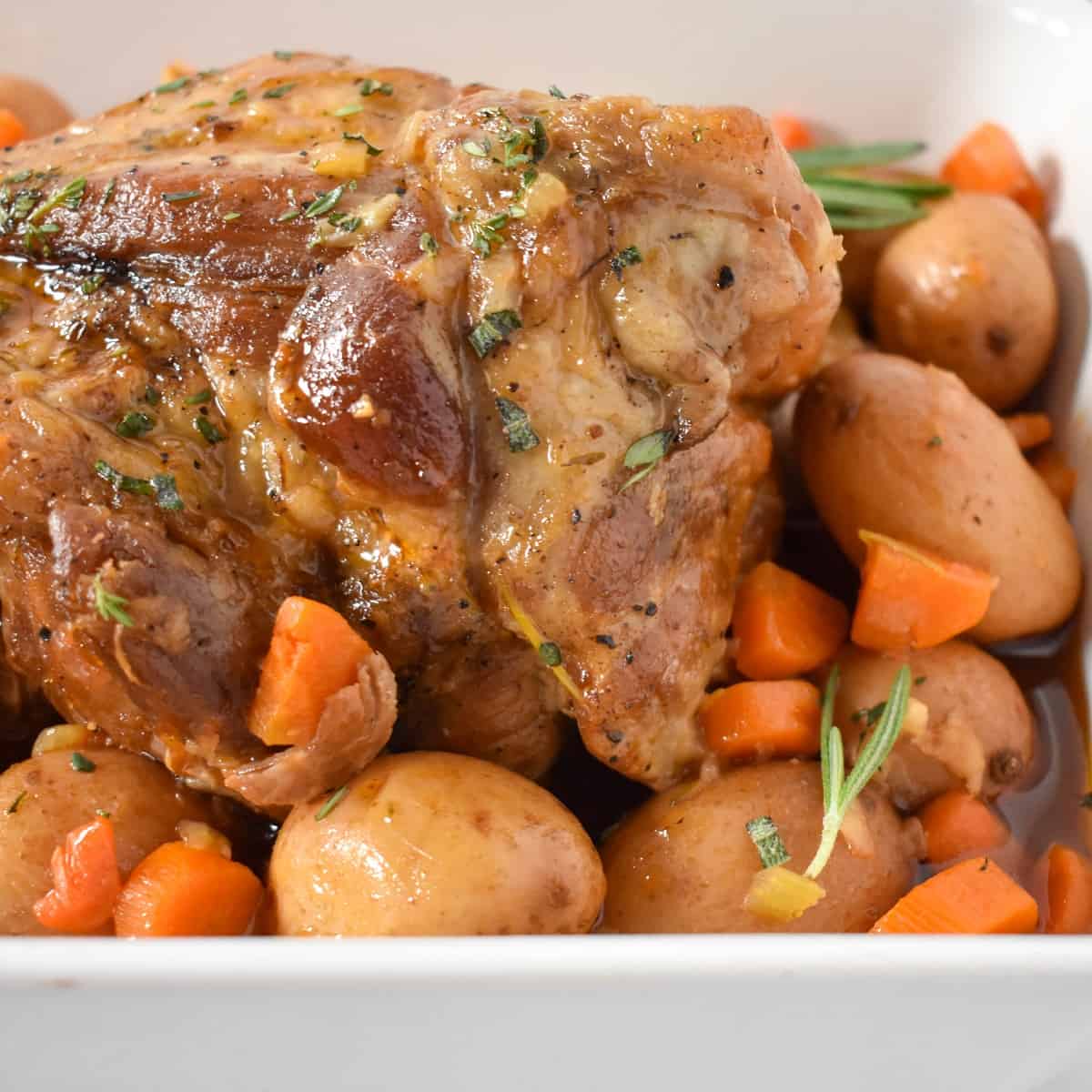
What's new in this recipe
This recipe was originally published on July 20, 2022, and we've made some fantastic updates! The instructions are now numbered for easier reference, and we've enhanced the tips and notes section to help ensure your success. We've also expanded the substitutions and variations section to include more options, added a slow cooker method, and included convenient "jump to" links for simple navigation.
What's great about this recipe
- Easy and comforting: This pork pot roast is a simple, satisfying meal made with everyday ingredients, perfect for family dinners or Sunday gatherings.
- Budget-friendly: If you love a classic pot roast but want to save money, this pork version is a fantastic option-typically costing about half the price of a beef chuck roast (prices may vary by location).
- Versatile cooking methods: Whether you prepare it on the stovetop or in a slow cooker, this recipe adapts easily to your kitchen setup and schedule.
- Hearty and flavorful: The tender pork, vegetables, and rich broth combine for a dish that's filling and full of flavor.
- Meal prep-friendly: Leftovers reheat beautifully and can even be repurposed into sandwiches and tacos, making it a great recipe for meal planning.
Jump to:
Ingredients
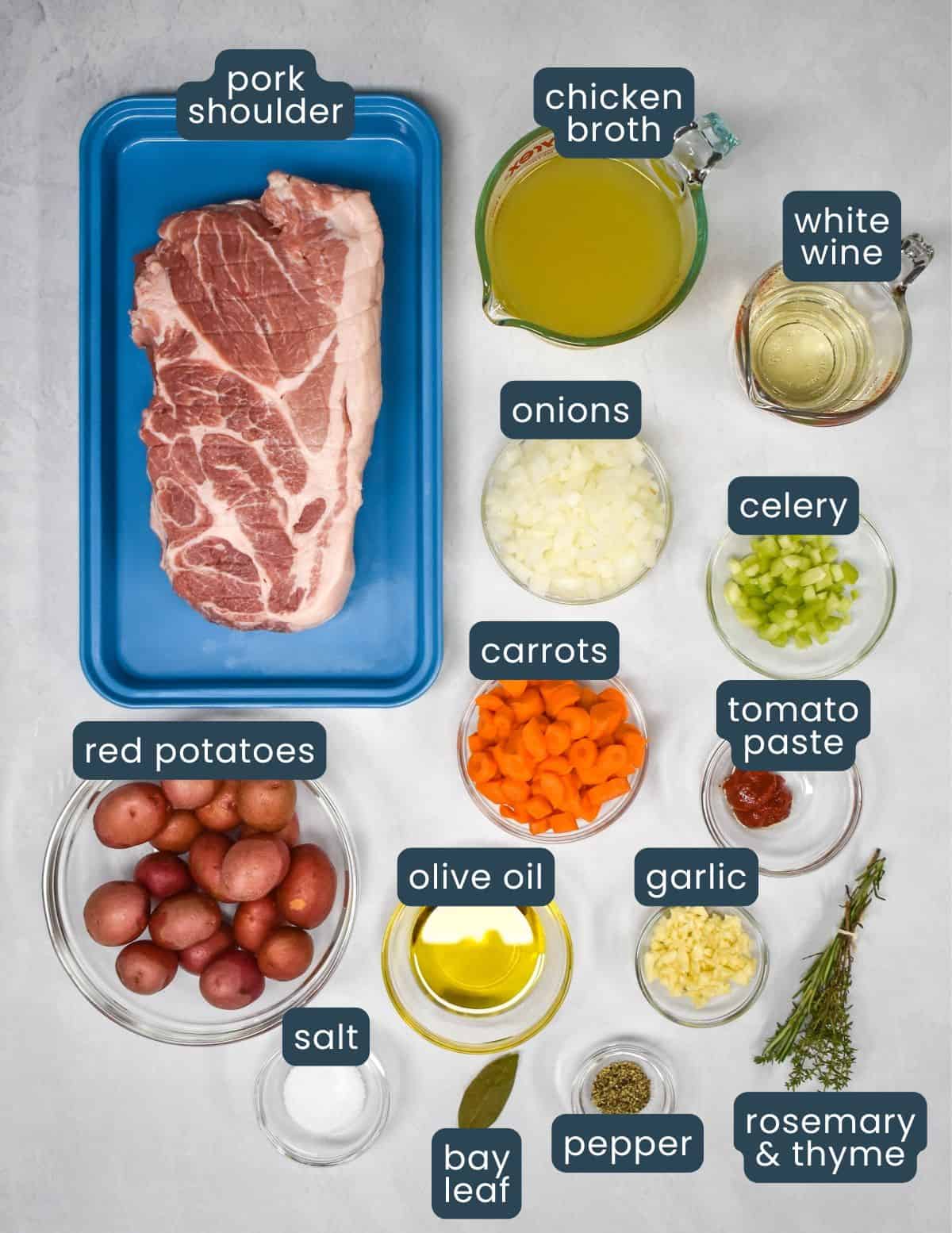
- Pork - Use one of the shoulder cuts, either the picnic or the butt. Buy a boneless piece or ask the butcher to remove the bone for you.
- Herbs and spices - The pork is simply seasoned with salt and black pepper. Fresh thyme, rosemary, and a bay leaf add depth of flavor.
- Oil - Olive oil is used to brown the pork and sauté the vegetables. You can also use your favorite oil, as long as it holds up to moderate heat.
- Produce - Onions, celery, and garlic bring additional flavor to the dish. Carrots and small red potatoes are cooked along with the pork, making this a hearty, flavorful dish.
- Pantry - Tomato paste enhances the flavor and adds a rich color to the dish. White wine is used to deglaze the pot after sautéing the vegetables, and chicken broth serves as the braising liquid.
- See the recipe card for quantities and preparation.
How to cook pork pot roast
Prepare the pork: Trim any large pieces of fat or the fat cap from the pork roast (if desired). Tie the roast with kitchen twine for even cooking. Season all sides generously with salt and pepper.
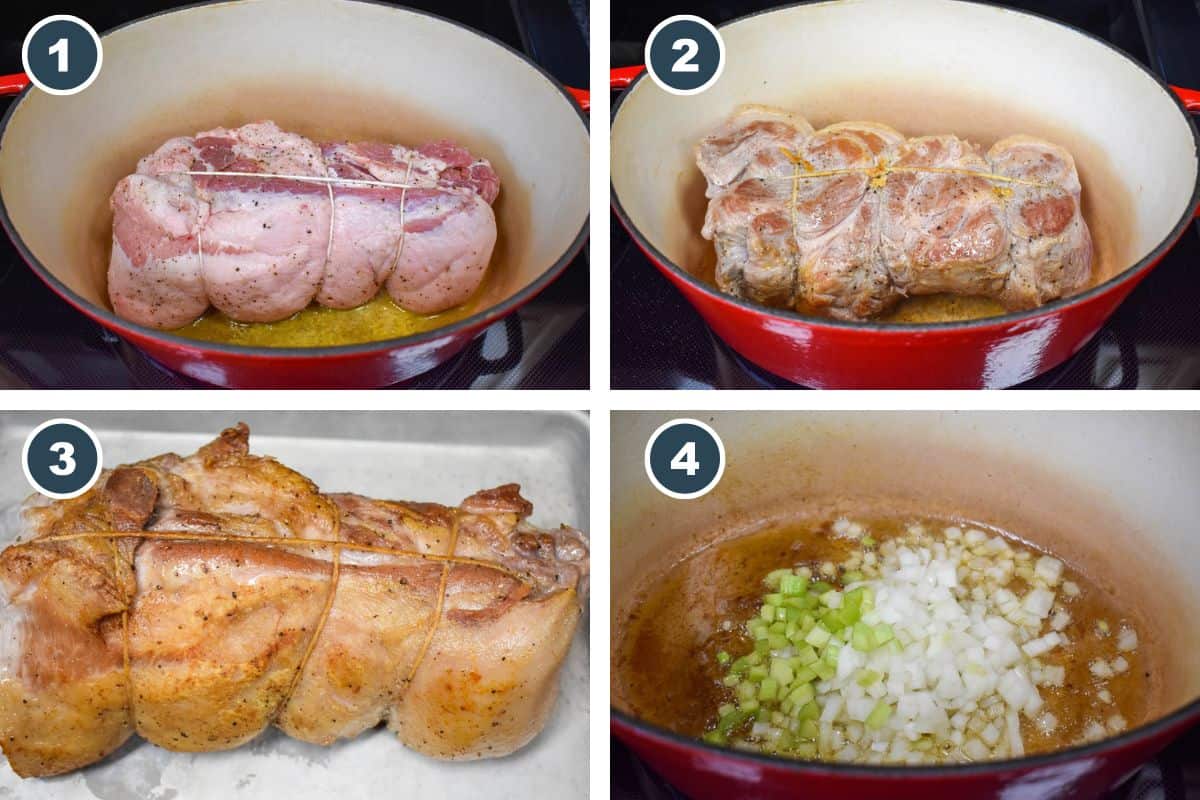
- Heat the olive oil in a large, heavy pot over medium heat. Sear the pork for approximately 3 minutes on each side.
- The meat will release from the pot once a crust forms on the outside. If it is sticking to the pot, give it another minute and try again.
- Take the pot off the heat. Transfer the roast to a pan or large platter and cover it loosely with foil to keep warm.
- Do not wash the pot. Place it back over medium heat. Add the onions and celery. Cook gently for 2-3 minutes, stirring frequently.
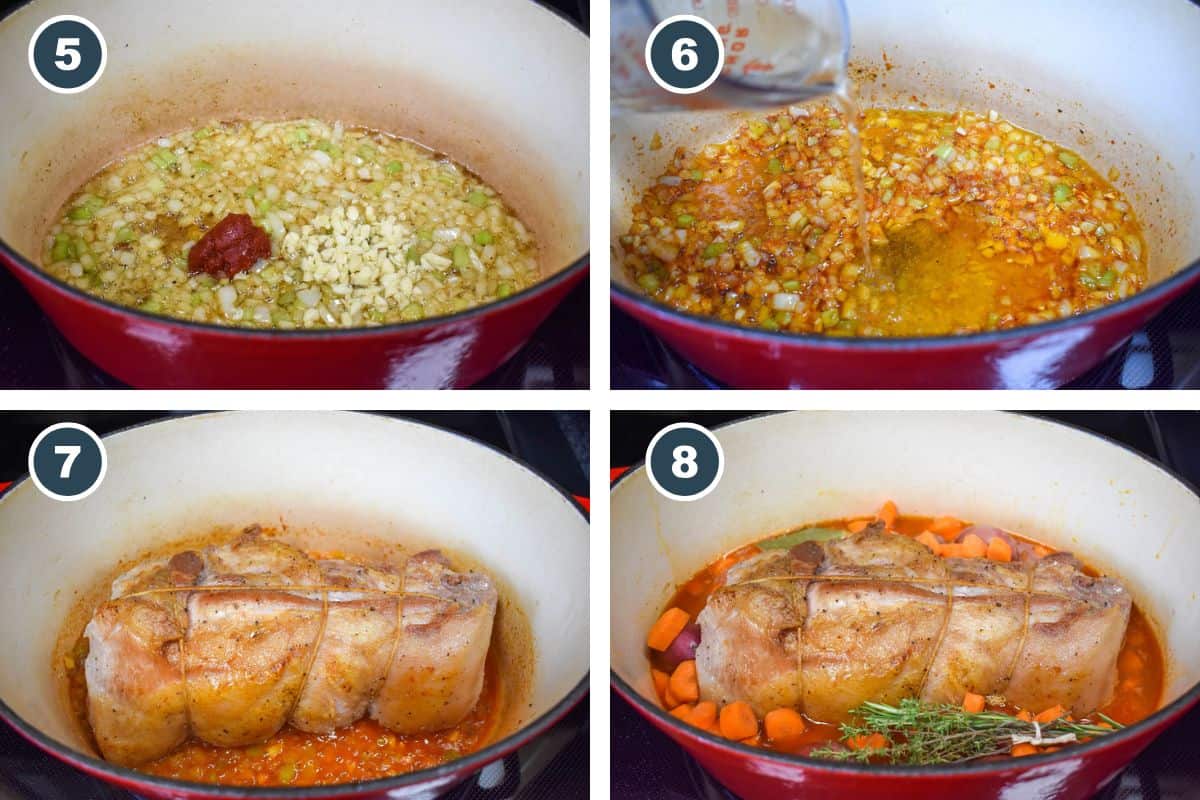
- Next, add the garlic and tomato paste to the pot. Stir well and cook for 1 minute.
- Pour in the white wine while gently scraping up any bits from the bottom of the pot. Cook for 1-2 minutes until most of the wine cooks out.
- Return the pork roast to the pot, along with any juices collected on the pan.
- Add enough chicken broth to cover ¼ of the roast. Arrange the potatoes, carrots, herbs, and the bay leaf around the meat.
- Raise the heat to medium-high to bring the broth to a simmer. Then, lower the heat to medium-low and cover the pot.
- Cook for about 3 - 3½ hours, or until it's fork-tender and tears easily. It should reach at least 195°F to 205°F to achieve the perfect fall-apart tenderness.
- During the cooking time keep the liquid simmering, raise or lower the heat as needed. Check on it every ½ hour or so, especially after raising or lowering the heat.
- Transfer the roast in a shallow dish or rimmed platter. Cut the cooking twine, remove, and discard. Surround it with the potatoes, carrots, and some cooking liquid. Garnish with fresh herbs, if desired.
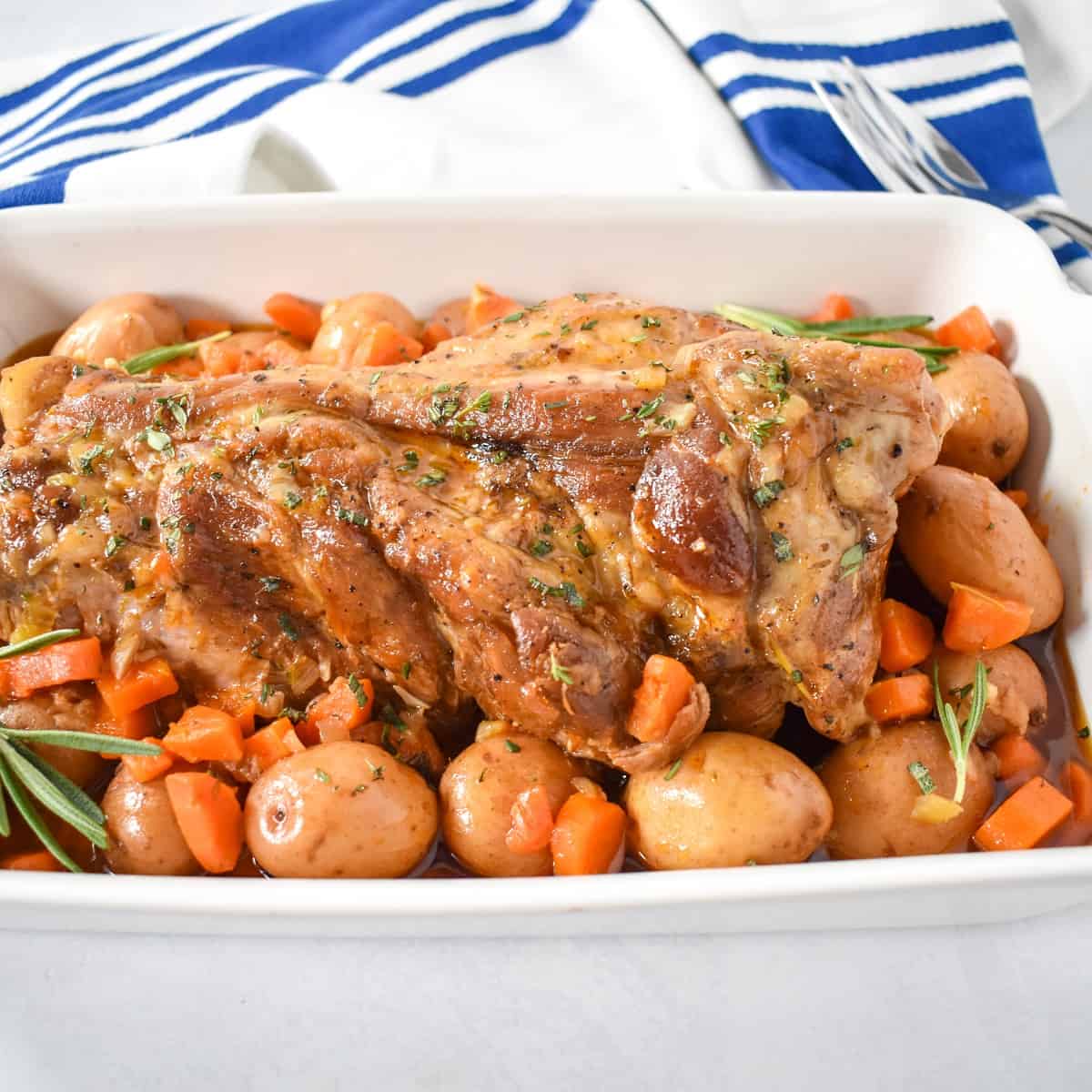
Slow cooker option
Season the pork with salt and pepper. Heat 2-3 tablespoons of oil in a skillet over medium heat. Sear the pork on all sides until browned, about 2-3 minutes per side. This step adds flavor but can be skipped if you're short on time. Place the onions, celery, carrots, and whole small potatoes in the bottom of the slow cooker. Lay the pork roast on top. In a bowl, mix the tomato paste and chicken broth until combined. Pour over the pork and vegetables, ensuring the liquid reaches about ¼ of the way up the roast. Add the herbs and bay leaf. Cover and cook on low for 8-10 hours, or until the pork is fork-tender and the vegetables are cooked through.
Substitutions and variations
- If fresh herbs aren't available, substitute with dried herbs, but reduce the amount to about ½ teaspoon of each.
- If you prefer not to use wine, deglaze the pot with chicken broth instead. Use the same amount and follow the same instructions.
- Substitute low-sodium broth and reduce the salt used to season the meat if you're sensitive to salt.
- Swap small red potatoes with baby Yukon Golds, creamer potatoes, or fingerlings. These varieties are small, can be kept whole, and hold up well to the long cooking time.
- To easily make this recipe gluten-free, use certified gluten-free chicken broth and verify that the white wine, tomato paste, and packaged herbs or spice blends are gluten-free. Always check ingredient labels to ensure compliance.
Storing and reheating instructions
- Refrigerator: Allow the pork pot roast to cool completely before storing. Transfer the meat and vegetables to an airtight container, along with some of the cooking liquid to keep everything moist. Refrigerate for 3-4 days.
- Freezer: Cool the pot roast quickly and transfer it, along with the cooking liquid, to airtight, freezer-safe containers. Leave about an inch of space to allow for expansion. Label the container with the contents and date. Freeze for up to 3 months.
- Reheating:
- Stovetop: Place the desired portion of pork (sliced or cut into chunks) and vegetables in a non-stick skillet with a few tablespoons of the cooking liquid. Cover and heat over medium-low, stirring or turning occasionally, until heated through.
- Microwave: Transfer a portion of pork and vegetables to a microwave-safe dish. Add a bit of the cooking liquid, cover loosely, and heat in 1-minute intervals, stirring or flipping the meat between intervals, until hot.
- Oven: Preheat the oven to 350°F. Place the pork and vegetables in a small baking dish with some of the cooking liquid. Cover the dish tightly with foil and heat for 20-30 minutes, or until warmed through.
- Reheating tip: Reserve the cooking liquid to add when reheating leftovers. It helps keep the pork and vegetables moist and enhances the flavor.
- Food safety: Reheat leftovers to an internal temperature of at least 165°F. For more information on food storage and safety guidelines, visit the U.S. Department of Agriculture and foodsafety.gov.
Recipe tips and notes
- Choose small, whole potatoes like red, Yukon Golds, or creamer varieties. Avoid using cut potatoes, as they may break down during the long cooking time.
- Depending on the cut of pork used, there may be a slit where the bone was removed. Use kitchen twine to tie the roast together to help it hold its shape and ensure even cooking.
- Tie the thyme and rosemary sprigs together with kitchen twine to make them easy to remove from the pot before serving.
- Use a pot large enough to fit the roast with space to arrange the carrots and potatoes around it. We used a 7-quart enameled cast iron Dutch oven-it was snug but worked perfectly.
- Searing the meat before braising develops a rich flavor and enhances the color of the dish.
- Shred leftover pork and mix it with the remaining vegetables and cooking liquid to create a stew-like dish or use it for sandwiches or tacos.
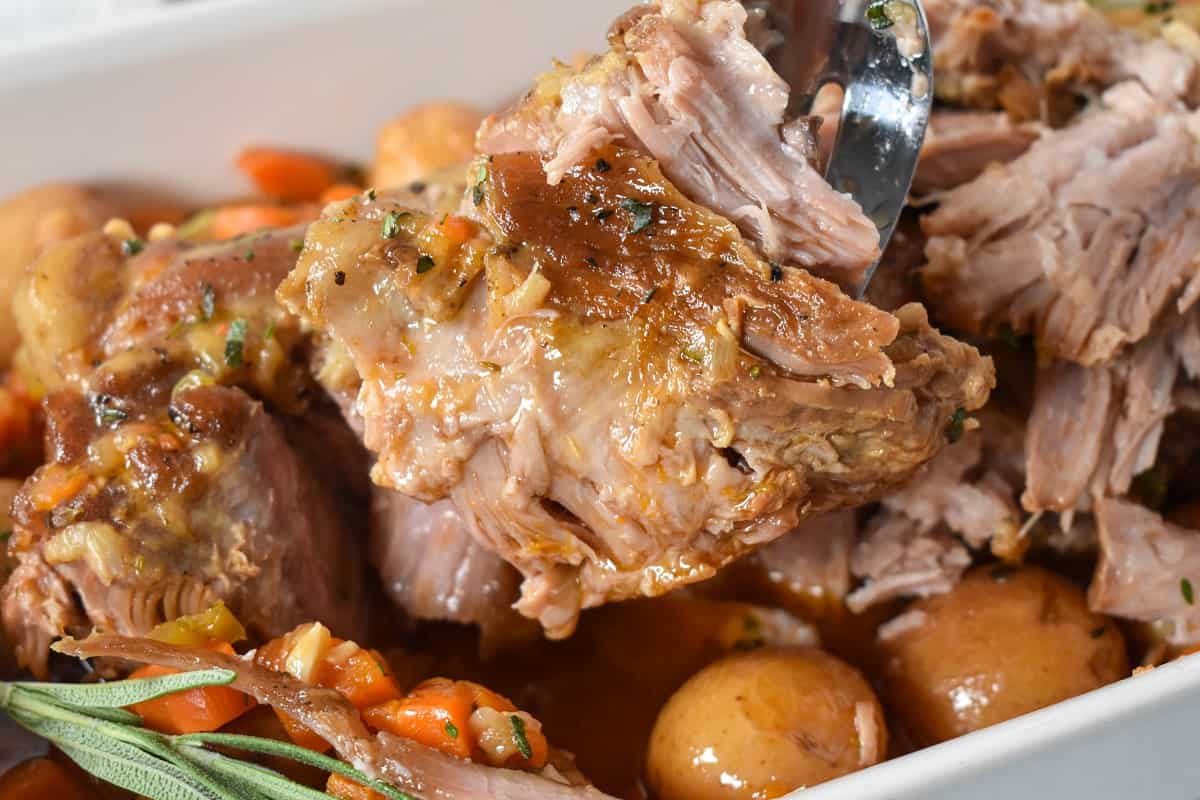
Frequently asked questions
The best cut is pork shoulder, which is a relatively tough cut of meat that benefits from long, slow cooking. The shoulder consists of two cuts: picnic shoulder and pork butt (also known as Boston butt). Both cuts work beautifully for pot roast.
On the stovetop, it will take approximately 3½ hours for a 4-5 pound roast to become tender and flavorful.
Serve this pot roast with seasoned rice, crusty bread, Texas toast, or mashed potatoes. Other great options include a fresh green salad, coleslaw, roasted vegetables, or marinated tomatoes.
Using pork instead of beef for pot roast is a fantastic way to save money without sacrificing flavor. If you're looking for more delicious pork roast recipes, be sure to check out our slow roasted pork shoulder, our popular Cuban roast pork, and our roasted pork butt with garlic and herbs. These hearty and flavorful dishes are perfect for creating wonderful meals the whole family will love.
Join Us
Subscribe to our newsletter to get the latest recipes, cooking tips, and kitchen inspiration delivered straight to your inbox. Remember to follow us on social media for daily recipe ideas and more!
📖 Recipe
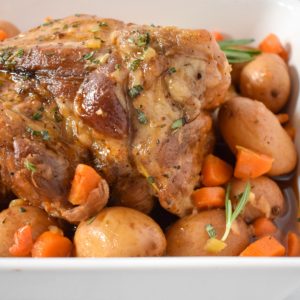
Pork Pot Roast
Ingredients
- 4-5 pounds Boneless Pork Shoulder picnic or pork butt (aka Boston butt)
- 2 teaspoons Salt
- ½ teaspoon Black Pepper
- 3 tablespoons Olive Oil
- 1 Medium Onion finely diced
- 1 Celery Stalk diced
- 3-4 Garlic Cloves minced
- 1 tablespoon Tomato Paste
- ½ cup White Wine
- 2-3 cups Chicken Broth enough to cover ¼ of the roast
- 3-4 Thyme Sprigs
- 1 Rosemary Sprig
- 1 Bay Leaf
- 2-3 Carrots cut into ½-inch rounds (about 1-1½ cups)
- 1 pound Small Red Potatoes keep whole, do not cut them
Instructions
- Trim any large pieces of fat or the fat cap from the pork roast (if desired). Tie the roast with kitchen twine to hold it together and ensure even cooking.
- Season the pork roast with salt and pepper on all sides.
- Heat the olive oil in a large, heavy pot over medium heat. When the oil is hot but not smoking, add the pork shoulder.
- Sear the pork for approximately 3 minutes per side until browned. The meat will release from the pot when a crust forms. If it sticks, give it another minute before turning. Repeat until all sides are browned.
- Remove the pot from the heat. Transfer the pork to a pan or large platter and loosely cover with aluminum foil to keep warm.
- Without washing the pot, return it to medium heat. Add the onion and celery, stirring frequently, and cook for 2-3 minutes.
- Add the garlic and tomato paste. Stir well and cook for 1 minute, stirring frequently.
- Pour in the white wine and stir, scraping any browned bits off the bottom of the pot. Cook for 1-2 minutes until most of the wine has evaporated.
- Return the pork roast to the pot, including any juices collected on the platter.
- Add enough chicken broth to reach ¼ of the way up the thickest part of the roast.
- Arrange the potatoes, carrots, thyme sprigs, rosemary sprig, and bay leaf around the roast.
- Raise the heat to medium-high and bring the broth to a simmer. Lower the heat to medium-low, cover, and cook for 3-3½ hours, or until the pork is fork-tender and tears easily when twisted with a fork.
- During cooking, keep the liquid at a gentle simmer. Adjust the heat as needed and check every 30 minutes, especially after making heat adjustments.
- Remove and discard the rosemary, thyme stems, and bay leaf.
- Transfer the roast to a shallow dish or rimmed platter. Cut the cooking twine, remove, and discard. Surround it with the potatoes, carrots, and some cooking liquid. Garnish with fresh herbs, if desired, and serve with your favorite sides.
Notes
- Choose small, whole potatoes such as red, Yukon Gold, or creamer varieties. Avoid cut potatoes, as they may break down during the long cooking time.
- Tie the thyme and rosemary sprigs together with kitchen twine for easy removal before serving.
- Use a pot large enough to fit the roast with space to arrange the carrots and potatoes around it. We used a 7-quart enameled cast iron Dutch oven.
- Searing the meat before braising adds rich flavor and enhances the dish's color.
Nutrition
The nutritional information above is computer generated and is only an estimate. There is no guarantee that it is accurate. This data is provided as a courtesy for informational purposes only.

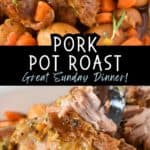
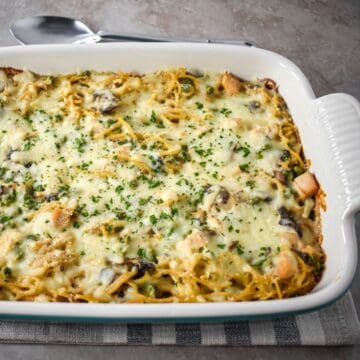
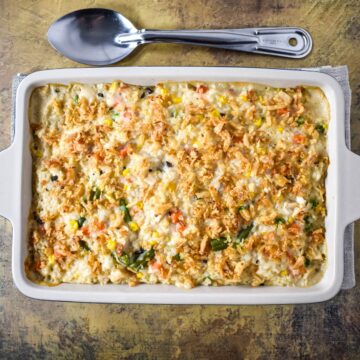

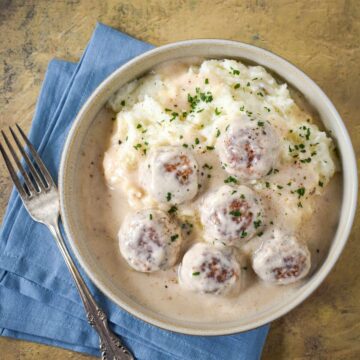
Tiana
Honestly was the best pork roast I have ever had!! Minor changes for family and what I had in the kitchen. *chefs kiss* will never loose this recipe if I had to get it tattooed on my ribs😂
Karla
There's no temperature listed for the oven.
Elizabeth
Hi Karla,
This pork pot roast is cooked low and slow on the stovetop, not the oven.